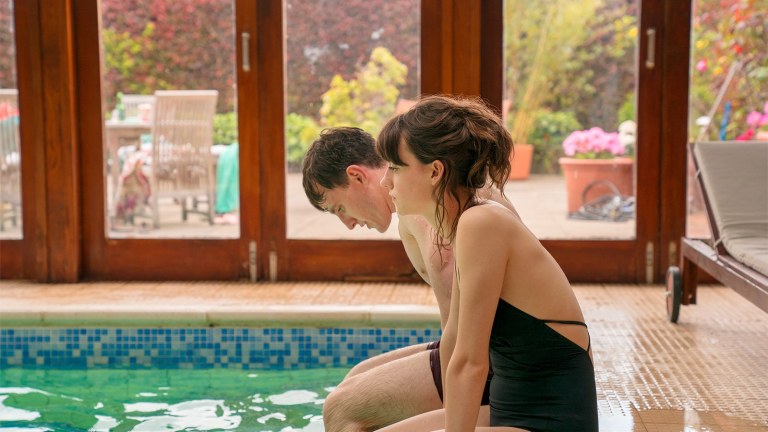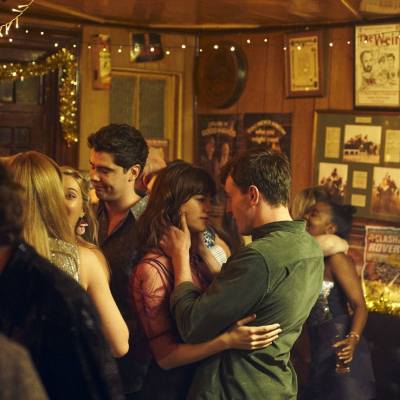Normal People Review (Spoiler-Free)
Hulu's Normal People is a vivid and intimate look at young, messy love, anchored by two powerfully vulnerable performances.

This Normal People review is based on all 12 episodes. It contains minor spoilers.
Normal People, the adaptation of Sally Rooney’s bestselling 2018 novel of the same name, has a simple plot but tells an emotionally-complex story, which makes it an ambitious choice for screen adaptation. Irish production company Element Pictures, which made the series for Hulu and BBC, obviously knew what it had, taking the time to bring together the right (mostly Irish) cast and crew, including Rooney and Oscar-nominated director Lenny Abrahamson (Room, Frank), to tell this beloved story. A half-hour series told in 12 parts, Normal People is a project done with a great respect for its source material—a strategy that, in this case, delivers for both fans of the novel and newcomers with an interest in tautly-drawn romance alike.
For those who haven’t read the literati darling, Normal People is the story of two young people falling and staying in love in contemporary Ireland. One is a working class boy named Connell (Paul Mescal). The other is a wealthy girl called Marianne (Daisy Edgar-Jones). In many ways, Marianne and Connell are alike. They come from the same small, fictional town in the West of Ireland, and they both have academic inclinations. They see the world in similar ways, and have many of the same holdups (most narratively-relevant, communication issues), which makes the relationship between them so much more complicated than it needs to be, but in the most realistic of ways.
The story begins when the Marianne and Connell are in their final year of high school. Marianne is not well-liked. Seen as arrogant and uninterested in many of the things the “normal” high-schooler cares about, she spends her days calling out teachers for what she sees as arbitrary rules and ignoring most of her peers. Connell, on the other hand, is “good” at high school. He is handsome and athletic. He is quiet-mannered and rarely rocks the boat, caring much more about what others think than Marianne does, or at least demonstrating himself to be much more willing to make decisions based on others’ presumed and actual reactions.
Connell’s mother cleans Marianne’s family’s house, which gives the two a chance to talk outside of the rigid social structure of school. In these small pockets of time, the two learn just how much they like and are attracted to one another and begin to have sex, keeping it a secret per Connell’s wishes. As you might imagine, this eventually blows up in Connell’s face and the two graduate high school and leave for college not speaking, with the shards of a relationship despite their mutual affection for one another.
As the two brightest students from their school, both Marianne and Connell end up at the prestigious Trinity College in Dublin, where it’s only a matter of time before they cross paths again, now in a new social context. In the privileged academic circle, Marianne is now considered the “normal” one. She is liked or at least admired by most, and has the space from but also the resources of her abusive family to thrive for the first time in her life, but doesn’t have the self-worth to be particularly discerning about whose “friendship” she should accept. Meanwhile, Connell is more obviously struggling. In addition to having to balance both school and the paid work required to afford to live and study in Dublin, he is surrounded by entitled college kids who talk all of the time yet say nothing. The two are different flavors of lonely… until they find each other again and again, in big and small ways.
There is an idea that external action is more exciting and marketable than internal action which, if you’ve ever read romance (or dived into the wonderful world of fanfiction, which resists attempts at commercialization but is massively popular), you know is not the case. A lot can happen within the complex scatter plot of emotions inside of all of us, and not enough of our prestige TV narratives embrace that potential. Too few screen projects, both adaptations and original works, value the complex representation of emotional interiority—perhaps because it is so hard to do on screen, and the cinematic language, a medium largely driven by men, has rarely valued it. Normal People lives in that mostly neglected space (see also: Skam or Skins) and is not unaware of the difficulties of translating this kind of story to the screen.
“In some ways, Normal People is a novel about the differences between the characters’ outer and inner selves, so we had to find new ways to dramatize those differences on screen,” Rooney, who wrote the first six episodes, said of the experience. (Lady Macbeth screenwriter and Succession Season 2 story editor Alice Birch wrote the bulk of the rest, with playwright/screenwriter Mark O’Rowe penning one.)
Rooney is a literary master at representing the space of things unsaid—in a conversation, in a relationship, in a life lived. It’s an impressive storytelling skillset in any medium and oh-so-specific, which makes translating it from prose to cinematic language a real challenge. The screen adaptation mostly does an impressive job, in terms of both the script and the direction, but there are some stumbles along the way.
In the novel, the alternating POVs of the characters creates a narrative balance that doesn’t always translate to the screen. In early episodes, we spend more time with Marianne than we do Connell, which gives her perspective more weight. This is partially written into the story—after all, Connell is arguably the more stoic character. While Marianne plays things close to the chest, Connell is not only often unable or unwilling to express his emotions, but often unable to identify or understand them in himself. This changes as the series progresses, with later episodes allowing Connell’s emotional interiority more space to be represented and explored.
Visually-spearheaded by Abrahamson, the producers behind Normal People obviously knew that they needed to find a filmmaker with a strong and confident authorial vision to match Rooney’s discerning prose. While Abrahamson (and Doctor Who director Hettie Macdonald, who shot the back half), may not demonstrate the same degree of narrative economy as Rooney, they bring a visual depth to the world that acts as a rich backdrop to the most important subjects (Marianne and Connell, often shot in close-up) without ever distracting from them.
Abrahamson and Macdonald should also be recognized for the space they created for their two main actors to give such brave and vulnerable performances. This adaptation rests, in large part, on relative newcomers Edgar-Jones (War of the Worlds) and Mescal (a theater actor, in his screen debut); the series doesn’t include a scene without at least one of them in it, and the young actors don’t waste a moment of it. Edgar-Jones nails Marianne’s cold, disinterested veneer and her deeper, self-critical vulnerability; her transformation from awkward schoolgirl to hip college student is particularly well done. Mescal’s transformation is less pronounced with the young actor getting more, richer opportunity to showcase his skills as the series progresses. Throughout, however, Mescal imbues Connell with a deep empathy that is integral to the character and to the central relationship.
Normal People works best when Edgar-Jones and Mescal are on-screen together, as it should. This is where the adaptation pains of limited character interiority fade away as the space (or not) between Marianne and Connell becomes much easier to track. It is in these moments, when the tension (sexual, romantic, intellectual) between these characters becomes visceral in a way that justifies this adaptation, if you needed justification for one of the best novels of the last decade to be further explored.
Perhaps this is why the weakest of the series’ episodes comes when the two are separated by physical distance rather than domestic issues. Then, and in other places where the amount of narrative movement does not match up with the duration of screen time, the layered and complex performances are hindered by the pacing of the script. This narrative shapelessness is most notable in the middle of the series, and particularly plagues an episode that sees both protagonists suffering from mental illness, a subject that while respectfully and responsibly-handled, doesn’t get the narrative time it needs to fully flesh out these common experiences in the context of these specific characters.
Other times, the narrative is muddled by non-linear editing and/or narrative structure that is especially and sporadically utilized in moments of pain and trauma. While the decision is an interesting one, the narrative logic is not consistent, which can make these sequences confusing—not in terms of plot, but in relation to character. In these moments, it can be hard to follow where Connell and Marianne are emotionally, both when it comes to themselves and each other. While this ambiguity was tightly-controlled in the book, here it feels unintentionally jarring.
Notably, Normal People isn’t afraid to use sex and, more broadly, physical intimacy, to tell its story, setting it apart from much else of what is on television. For a very long time on television, sex was portrayed in a very specific way, which was not at all. A couple would kiss passionately on screen before cutting to the morning after. Everything else was implied, which is a massive missed narrative opportunity, one that was and still can be dictated by (when it comes to American broadcast TV) FCC rules. In this way, cable and streamers have the narrative edge, but too rarely take it. Using sex as a way to titillate or shock rather than as a tool to tell the story.
Sex is a narrative action that can tell us a lot about characters and their relationships with one another. Storytellers can choose to depict silly sex, awkward sex, desperate sex, etc. In Normal People, Marianne and Connell have honest sex, which is to say they see one another and allow themselves to be seen in return—something they haven’t quite worked out how to do outside of the bedroom. Some of the series’ most affecting, complex moments come in these scenes of intense intimacy. The respectful, narratively-rich way Normal People approaches both sex scenes and full-frontal nudity may become one of the TV series’ enduring legacies.
While the Normal People series has pacing problems that might not have happened with an original story, this is a screen world that, like its source material, encourages as much lingering as possible to prolong its inevitable end. One does not read Normal People; one ensconces themself in its world. The same can be said for this faithful adaptation. The series doesn’t fall far from its exquisitely vivid source material, which will make it an emotional and transformative experience for fans of the novel and newcomers alike. In this new form, Normal People remains the kind of story that stays with you long after you’ve closed the laptop and, in a time of social distancing, reminds us just how powerful a thing it can be to be touched.
Normal People drops in its entirety on BBC Three in the UK on April 26 and on Hulu in the US on April 29. It will also premiere on BBC One on April 27 at 9 p.m. with two 30-minute episodes and will air weekly.


